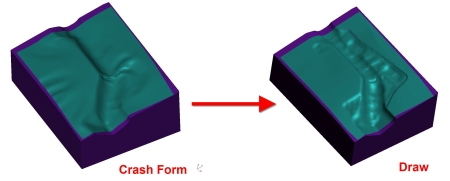What’s the difference between a crash and a draw form?
To many toolmakers this may seem a simple question, however, for those new in the industry or without much experience, it is worth explaining in more detail. A crash form means that a male punch and a female die are closed together without any springs, cushions or otherwise to hold the blank as the forming process takes place. The punch and die simply “crash” together.
The method is successful on simple, shallow parts with basic shapes. Basically, the flow of material cannot be controlled in this method, and that is why wrinkling results in deep parts.
Parts can be “crashed” from a square blank and then trimmed OR a blank can be trimmed first and then crashed. The latter is the cheapest tooling method.
A draw form is usually designed to control the stretch of the material to prevent wrinkles and stretch the material evenly. This is done by a blank holder OR binder. The binder is often a flat surface that is mounted on high-force gas springs. Usually, it surrounds the punch. This means as the die closes, the blank is held around the edges very tightly first, then stretched over the punch. The flow of material can be controlled by the binder shape, the holding force and the placement of draw beads (to further stop material flowing, as might be required to stop wrinkles). This almost always means that the blank is square and larger than that required in a crash form. Furthermore, the drawn panel almost always needs to be trimmed after drawing and possibly formed again into the final shape.

Because of the cost implications, whenever possible, toolmakers and sheet metal stampers like to use a crash form. However, it is often difficult to know if a crash form process will produce a panel free from wrinkles and splits.
With forming simulation, a crash form simulation result will quickly tell you whether or not a crash form process is feasible for your part. This is the most common request for forming simulation I receive.
We will leave you with the words of one of our customers who asked us to simulate a crash form on his part and discovered that a draw process was instead required: “I am convinced you saved my customer thousands of dollars. Thanks again.”
